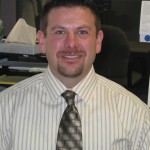The field of X-ray and radiology in healthcare has come a long way since 1895. With advances in technology and machinery, the field has grown at an exponential rate. For all you technologists out there in the field of diagnostic imaging, you have Wilhelm Conrad Röntgen to thank. His early invention gave others the ability to develop new, life-saving devices such as CT, MRI, Ultrasound, rapid film processors, digital imaging, and invasive procedures, just to name a few. Let’s learn a bit more about the inventor of the x-ray.
Wilhelm Conrad Röntgen, born on March 27, 1845, was a German physicist. On November 8, 1895, he produced and detected electromagnetic radiation in a wavelength range today known as X-rays. That achievement earned him the Nobel Prize in Physics in 1901. The invention of the X-ray is one the most influential and important factors in today’s modern medicine. Wilhelm Röntgen’s invention allows us to look into the body and see how it works. The advancement of the X-ray and the modalities that it was a factor in creating has been remarkable. X-rays define anatomy and disease. It has transitioned to molecular imaging to diagnose function and the process of disease. It now fuses anatomy and physiology to give us the most accurate assessment of disease as well as the response to treatment, becoming instrumental in personalized medicine.
As with most great minds, Wilhelm was a character. Here are some interesting facts about him:
He was an eccentric. He conducted his experiments in secret and wouldn’t allow witnesses. When he lectured and taught classes at universities, students had a hard time following him because he jumped from concept to concept so quickly. He also left instruction that upon his death all his scientific findings be destroyed.
He discovered the X-ray by accident. Not uncommon to other great inventions, he discovered the X-ray while conducting other experiments. He was experimenting with cathode rays by trying to repeat past experiments in which rays could penetrate glass. He covered one of the tubes with black cardboard and fed the cathode ray an electric current. He didn’t put a screen in front of the tube, as he had done in the past. The glowing tube left an impression on the cardboard in the form of an “A” written by a student in liquid barium platinocyanide. He reproduced the scenario again with a deck of cards and a book, where he could clearly see through the tube and screen.
He never completed high school. He was kicked out of a technical college for a prank he was blamed for, which was actually committed by another student. Even without high school and the necessary credentials, he entered the University of Utrecht and earned his Ph.D. in Mechanical Engineering in four years. He went on to become a renowned physicist and received several offers to teach at universities, including the one that expelled him.
He didn’t want any profits or royalties from his work. Becoming a world renowned scientist often has its perks, especially monetarily. Accomplished scientists earn a handsome income from patents, royalties, and professorships. Wilhelm didn’t want any part of that. He never patented his invention or sought excess profits from his work. He even donated the money he earned from the Nobel Prize to a university.
On behalf of all the talented people we work with in the x-ray and radiology field, Aureus Medical Group would like to wish a very happy 169th birthday to Wilhem Conrad Röntgen!
 Chad Mislivec joined Aureus Medical Group in February 2005 as an Account Manager for the MedSearch division. He coordinated direct hire recruitment services for clients and helped candidates find direct hire (full-time) positions. He now holds the title of Senior Account Manager and Team Lead for the Imaging division, coordinating team efforts to provide total staffing solutions in healthcare facilities while directly working with clients. In his free time, Chad enjoys spending time with family, exercising, golfing, and watching football.
Chad Mislivec joined Aureus Medical Group in February 2005 as an Account Manager for the MedSearch division. He coordinated direct hire recruitment services for clients and helped candidates find direct hire (full-time) positions. He now holds the title of Senior Account Manager and Team Lead for the Imaging division, coordinating team efforts to provide total staffing solutions in healthcare facilities while directly working with clients. In his free time, Chad enjoys spending time with family, exercising, golfing, and watching football.
